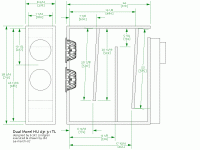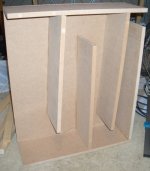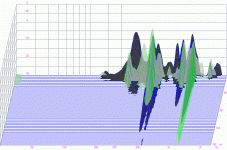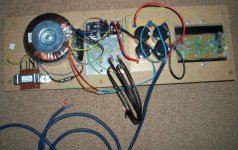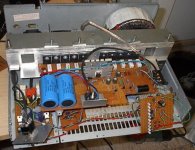Getting bits together now. There are lots of components coming from lots of places, mainly for the amplifier. I have the wood (ended up 18mm MDF, nothing much else available  ) cut and ready in the garage.
) cut and ready in the garage.
One thing before I start gluing it together though is the amplifier mounting. It's turned out a little larger/longer than I expected. If mounted as shown in the picture will I experience any noticeable negative effects from it being there? It won't affect the TL line opening?
Also quickly, when gluing an edge of MDF to a face of MDF, the face is sort of shinier and less porous. Does it need anything done to it for the glue to hold well? Scoring it with a knife or file to reveal the looser material?
Cabinet should go together pretty quick overall with the panels being cut already
One thing before I start gluing it together though is the amplifier mounting. It's turned out a little larger/longer than I expected. If mounted as shown in the picture will I experience any noticeable negative effects from it being there? It won't affect the TL line opening?
Also quickly, when gluing an edge of MDF to a face of MDF, the face is sort of shinier and less porous. Does it need anything done to it for the glue to hold well? Scoring it with a knife or file to reveal the looser material?
Cabinet should go together pretty quick overall with the panels being cut already
Attachments
Cheers  . Got EVO-Stick or something glue, some kind of resin based wood glue I think. Dries shockingly quick though according to the container, will have to work fast with the clamps
. Got EVO-Stick or something glue, some kind of resin based wood glue I think. Dries shockingly quick though according to the container, will have to work fast with the clamps 

The amplifier mounting should be ok? Diffraction won't be an issue but I was concerned about it possibly altering the effective line length or similar
The amplifier mounting should be ok? Diffraction won't be an issue but I was concerned about it possibly altering the effective line length or similar
Dr.EM said:The amplifier mounting should be ok? Diffraction won't be an issue but I was concerned about it possibly altering the effective line length or similar
Should be OK... the best place thou is not attached to the woofe at all...
dave
Ok, a bit of progress. All simply glued and clamped together, really nice and effective.
Still waiting for drivers to arrive, may well finish the amplifier before then.
Noticed some things called "tie down ratchets" too. Are they a bit like a big belt you tighted with a ratchet? Could be ideal to hold the side panels on during gluing I thought, only £1.50 each too
Still waiting for drivers to arrive, may well finish the amplifier before then.
Noticed some things called "tie down ratchets" too. Are they a bit like a big belt you tighted with a ratchet? Could be ideal to hold the side panels on during gluing I thought, only £1.50 each too
Attachments
Dr.EM said:Noticed some things called "tie down ratchets" too. Are they a bit like a big belt you tighted with a ratchet?
Ratchet straps are very useful for clamping all sorts of things during glue ups. At that price, if they look reasonably well made, I'd probably buy half a dozen.
pinkmouse said:
Ratchet straps are very useful for clamping all sorts of things during glue ups. At that price, if they look reasonably well made, I'd probably buy half a dozen.
Also handy for restraining the patient after he's been driven silly trying to get the crossover right


Glad i'm going to be using active crossovers then 
 . Linkwitz 24db design as shown here (except set around 70hz):
. Linkwitz 24db design as shown here (except set around 70hz):
http://sound.westhost.com/project09.htm
Should be simple enough except for trying to use Burr-brown OPA2134 devices in the high pass section, might be an oscillaton nightmare with thier bandwidth
Got most the bits for the amplifier which is the ESP P101 design; high power version since this is 4ohm
http://sound.westhost.com/project09.htm
Should be simple enough except for trying to use Burr-brown OPA2134 devices in the high pass section, might be an oscillaton nightmare with thier bandwidth

Got most the bits for the amplifier which is the ESP P101 design; high power version since this is 4ohm
ic"
Hi
I have been following your project with the intention of building a set of subs for a set of full range electrostatics. I hope that your project is going well. I found these that may be of intrest:
http://www.soundlabsgroup.com.au/c/ICs/ICs.html, I have delt with the online store and they seem to be good. Please let me know how you go on the burr Browns.
Cheers
Greg
Hi
I have been following your project with the intention of building a set of subs for a set of full range electrostatics. I hope that your project is going well. I found these that may be of intrest:
http://www.soundlabsgroup.com.au/c/ICs/ICs.html, I have delt with the online store and they seem to be good. Please let me know how you go on the burr Browns.
Cheers
Greg
planet10 said:Another thing about MDF i just remembered -- i don't know if it is relevant, especially once a finish is applied, but MDF is not air tight. You will see on occasion a piece of 19mm MDF used as a convient platform for smaller pieces on a big vacuum hold-down CNC panel router. The vacuum sucks the top pieces down right thru the sheet underneath it,
We could have as much free MDF as we wanted. But we'd rather go out and buy BB ply because of the sonic benefits.
I am convinced that MDF has gained its status because some smart fellow promoted this new material (when i started speaker building it was not available -- we used K3 particle board) as new superior tech. He did it not because it was better, but because it was cheaper, cheaper to work with, and cheaper to finish. Now the myth is so ingrained even vetern speaker building companies believe it to be true.
dave
Dave learn how to build a decent box then. Just because you suck doesn't mean the MDF does.
Predominantly fullrange folks are odd. Its almost as if they're trying to be different just to stand out.
ShinOBIWAN said:Dave learn how to build a decent box then. Just because you suck doesn't mean the MDF does.
I can certainly build a decent box... i just can't make it pretty. My dislike of MDF for building boxes is rooted in 30 years of experience. In the early days i went from K3 particle board, to MDF, to HDF. Now plywood. I was never happy with MDF. It is particularily ill-suited for woofers.
dave
planet10 said:
I can certainly build a decent box... i just can't make it pretty. My dislike of MDF for building boxes is rooted in 30 years of experience. In the early days i went from K3 particle board, to MDF, to HDF. Now plywood. I was never happy with MDF. It is particularily ill-suited for woofers.
dave
I don't think anyone will disagree with you when you say Birch is superior. No doubt about that. But your catagorising MDF as somewhat unsuitable for loudspeaker cabinet use is something I've seen pop up periodically, sometimes subtly sometimes less so. It gets old and its inaccurate.
Fact is, MDF used correctly is a good material for loudspeaker construction. When I say correctly I mean properly braced ie. inter-bracing spacing ~10-15cm and smaller panel sizes to shift the resonances up. MDF's real problem is its ~200hz resonance.
To save arguing subjectives and just get down to it, lets take a look at the differences:
Here's a like for like accelerometer tests of unbraced 18mm MDF:
An externally hosted image should be here but it was not working when we last tested it.
And the same testing conditions applied to 18mm Birch Ply:
An externally hosted image should be here but it was not working when we last tested it.
Seems like swings and roundabouts to me. The MDF has a lower Q resonance at just under 200hz. The birch fares better here but not without comparatively worse issues at 600hz with a higher initial decay start level and more energy storage.
Now with modest bracing:
MDF:
An externally hosted image should be here but it was not working when we last tested it.
Birch:
An externally hosted image should be here but it was not working when we last tested it.
Birch is noticeably better here save for a narrow Q and rather diminished resonance at 1.2Khz. You probably couldn't even hear that at the level its at. Point is both are quite acceptable and this isn't even with serious bracing or lamination techniques ie. 10cm inter-spacing. So expect further improvements for both by doing so.
And finally 18mm MDF with bracing and mass loading using lead sheet:
An externally hosted image should be here but it was not working when we last tested it.
The best methods are somewhat impractical and no single homogeneous material offers ideal characteristics. It takes composites or steps like that last CSD to really say your cabinets aren't contributing unnecessary and unintended output over the drivers own efforts.
Like I said earlier, build it properly and MDF is a great material for loudspeaker construction. The last speakers I built used <= 15cm spacing for the bracing and a wall construction of 9mm+18mm MDF laminate with 3mm lead sheet applied internally and a further 2mm bitumen layer. Results is a dead cabinet.
BTW Sorry for saying you suck, clearly thats not the case at all! I read then typed before thinking like a human being.
The (modestly braced) MDF vrs ply pretty much says it and show why with a practical construction ply has a fair edge (blue is MDF/green is ply)... the resonances with ply are shifted upward where there is less energy to excite them -- did you see Svante's graph? -- and the Q on the ply is higher (ie narrower peaks) so that means energy has to be more concentrated to excite the resonance. The time that the ringing occurs at the low frequencies is also shorter which means less stored energy.
It would be interesting to normalize/convolve the actual data with Svante's chart which would put things into even more dramatic perspective.
Now pay for that in labour & shipping... cost is always a factor even when you aren't selling the boxes.
I've also built & then listened too very well built MDF vrs plywood boxes, and i'll take the plywood box any day.
dave
It would be interesting to normalize/convolve the actual data with Svante's chart which would put things into even more dramatic perspective.
Originally posted by ShinOBIWAN Like I said earlier, build it properly and MDF is a great material for loudspeaker construction. The last speakers I built used <= 15cm spacing for the bracing and a wall construction of 9mm+18mm MDF laminate with 3mm lead sheet applied internally and a further 2mm bitumen layer. Results is a dead cabinet.
Now pay for that in labour & shipping... cost is always a factor even when you aren't selling the boxes.
I've also built & then listened too very well built MDF vrs plywood boxes, and i'll take the plywood box any day.
dave
Attachments
planet10 said:The (modestly braced) MDF vrs ply pretty much says it and show why with a practical construction ply has a fair edge (blue is MDF/green is ply)... the resonances with ply are shifted upward where there is less energy to excite them -- did you see Svante's graph? -- and the Q on the ply is higher (ie narrower peaks) so that means energy has to be more concentrated to excite the resonance. The time that the ringing occurs at the low frequencies is also shorter which means less stored energy.
It would be interesting to normalize/convolve the actual data with Svante's chart which would put things into even more dramatic perspective.
I'm not trying to argue MDF is better than Birch, the opening sentence from my last post should have assured you of that. What I was trying to illustrate is that MDF is cheap, can be harnessed very well for loudspeaker cabinets and is a valid option.
Now pay for that in labour & shipping... cost is always a factor even when you aren't selling the boxes.
Here in the UK the average price of an 8' x 4' 18mm sheet of MDF is around £15, the Birch equivalent is £40-45.
I paid £150 for all the 18mm/9mm MDF I needed on my last project. For nice quality Birch ply it would have been nearly triple that. Looking back it cost me just over £100 for the lead, bitumen and shipping. So even with treatments I'm still laughing by an ~80% saving over the Birch on its own (~£450).
I really fail to see your point here. Had I gone with the Birch cabinet sans treatments then I'd not only have spent more than the option I went for but also would have a lesser cabinet(more resonant). And if I had gone with the full monty Birch cabinet then it would have been significantly more expensive(~£550 vs. £250) and only marginally improve upon an already near dead cabinet.
And as for labour, whether going for Birch or MDF you will spend roughly the same time on construction. Besides most folks go slow with the Birch because it costs you three times as much for every mistake!
I've also built & then listened too very well built MDF vrs plywood boxes, and i'll take the plywood box any day.
dave
I knew it would come to subjectivity at some point, I can't debate your opinion.

We're a funny old pair, me with my 'save the MDF' ramblings and you with the 'musical Birch'.
ShinOBIWAN said:Here in the UK the average price of an 8' x 4' 18mm sheet of MDF is around £15, the Birch equivalent is £40-45.
Here MDF is free (unless we need a full sheet -- then about $15) BB is <$25/sheet (wholesale and a lift at a time)
shipping
I also have to factor in the cost of shipping to the client.
I knew it would come to subjectivity at some point, I can't debate your opinion.But speaking of tastes, didn't you advocate for those Audionote 'musical' ply boxes at some point too? Or was it something along the lines of 'dead' cabinets sound wrong?

I'm no big fan of the Audio Note speakers. They do sound OK, but pricing is somewhat obscene -- the biggest plus is to be able to say we are targeting to build stuff as musically satisfying and cost less than the sales tax on the ANs.
Depends on how the dead box is dead. If it is because it is storing a lot of energy i don't like them. This is where the "traditional" knuckle rap test can be misleading.
dave
I'm using a 24db active filter at 70Hz and the TL itself provides moderate internal bracing so doubt I will encounter any real problems with this design.
Just a quick update since the thread has become more active again. I've been working on the amplifier for now since my drivers still arn't here (do Wilmslow normally take ages?).
The amp is working as planned, its an ESP P101 board populated as the high power version. This is powered at +/-42VDC by a 300VA transformer with 20,000uF capacitance per rail; it will be driving the 4ohm load of the 2 drivers combined.
It tests well with an old passive sub I have but that one bottoms out very quickly, well before any distortion appears on my scope, so no higher power tests can be performed properly (it is 8ohm anyhow, one of the cheap Audax 8" drivers).
Filters are half done, they will naturally run from the smaller laminated transformer. Using OPA2134 chips for the high pass, they are working fine, cheaper TL084 chips will be used for the sub filter and phase controller.
Just a quick update since the thread has become more active again. I've been working on the amplifier for now since my drivers still arn't here (do Wilmslow normally take ages?).
The amp is working as planned, its an ESP P101 board populated as the high power version. This is powered at +/-42VDC by a 300VA transformer with 20,000uF capacitance per rail; it will be driving the 4ohm load of the 2 drivers combined.
It tests well with an old passive sub I have but that one bottoms out very quickly, well before any distortion appears on my scope, so no higher power tests can be performed properly (it is 8ohm anyhow, one of the cheap Audax 8" drivers).
Filters are half done, they will naturally run from the smaller laminated transformer. Using OPA2134 chips for the high pass, they are working fine, cheaper TL084 chips will be used for the sub filter and phase controller.
Attachments
Originally posted by planet10 Here MDF is free (unless we need a full sheet -- then about $15) BB is <$25/sheet (wholesale and a lift at a time)
You can source Birch ply much cheaper than I from my local sources. If it were £25 a sheet here I'd use it all the time too.
I also have to factor in the cost of shipping to the client.
I certainly wasn't trying to convince you to start re-visiting MDF enclosures but just adding contrast to and addressing the points you've raised about MDF within this thread.
I'm no big fan of the Audio Note speakers. They do sound OK, but pricing is somewhat obscene -- the biggest plus is to be able to say we are targeting to build stuff as musically satisfying and cost less than the sales tax on the ANs.
It was a little fun poking. I've heard them myself and thought they were a nice easy listen.
Depends on how the dead box is dead. If it is because it is storing a lot of energy i don't like them. This is where the "traditional" knuckle rap test can be misleading.
dave
So long as the material in question shows minimal resonances with clean decay behavior what does it matter? A material that disapates the energy with less excitation, effective cancellation and more energy converted to heat is surely preferable to one that quickly loses energy into the surrounding air(read: sound) and material elasticity in the form of pleasant resonance signatures?
ShinOBIWAN said:
Predominantly fullrange folks are odd. Its almost as if they're trying to be different just to stand out.
HA. I can't stop laughing...
Dr.EM said:I'm using a 24db active filter at 70Hz and the TL itself provides moderate internal bracing so doubt I will encounter any real problems with this design.
The amp is working as planned, its an ESP P101 board populated as the high power version. This is powered at +/-42VDC by a 300VA transformer with 20,000uF capacitance per rail; it will be driving the 4ohm load of the 2 drivers combined.
Filters are half done, they will naturally run from the smaller laminated transformer. Using OPA2134 chips for the high pass, they are working fine, cheaper TL084 chips will be used for the sub filter and phase controller.
Looks promising. What made you chose Rod's P101? How about total cost for this amp? I know from my own experience, it's not cheap, especially power supply parts. It makes me wonder about the quality of a $150 plate amp, when it cost me almost that much for the transformer. I built (from scratch, no board) Rod's P68 - 500 watt version (pic below). It probably cost more than $500 for the parts alone (including shipping), but was worth the effort and expense. And hey, I had fun doing it!
Attachments
- Status
- This old topic is closed. If you want to reopen this topic, contact a moderator using the "Report Post" button.
- Home
- Loudspeakers
- Subwoofers
- PMC TLE1 style sub
